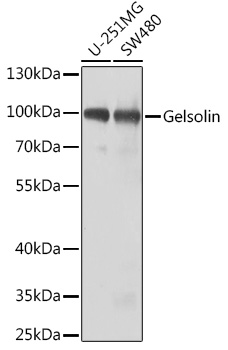![Gelsolin / Actin-depolymerizing Factor(CPTC-Gelsolin-1), CF405S conjugate, 0.1mg/mL [26628-22-8] Gelsolin / Actin-depolymerizing Factor(CPTC-Gelsolin-1), CF405S conjugate, 0.1mg/mL [26628-22-8]](https://biotium.com/wp-content/uploads/2016/12/placeholder.png)
Gelsolin / Actin-depolymerizing Factor(CPTC-Gelsolin-1), CF405S conjugate, 0.1mg/mL [26628-22-8]
BNC042239
ReactivityBovine, Human, Mouse
Product group Antibodies
TargetGSN
Overview
- SupplierBiotium
- Product NameGelsolin / Actin-depolymerizing Factor(CPTC-Gelsolin-1), CF405S conjugate, 0.1mg/mL [26628-22-8]
- Delivery Days Customer9
- CertificationResearch Use Only
- ClonalityMonoclonal
- Clone IDCPTC-Gelsolin-1
- Concentration0.1 mg/ml
- ConjugateOther Conjugate
- Gene ID2934
- Target nameGSN
- Target descriptiongelsolin
- Target synonymsADF, AGEL, AMYLD4, gelsolin, actin-depolymerizing factor, brevin, epididymis secretory sperm binding protein
- HostMouse
- IsotypeIgG1
- Protein IDP06396
- Protein NameGelsolin
- Scientific DescriptionGelsolin (also known as brevin, Actin-depolymerizing factor or ADF), a protein of leukocytes, platelets and other cells, severs Actin filaments in thepresence of submicromolar calcium, thereby isolating cytoplasmic Actin gels. It is a calcium-regulated, actin-modulating protein that binds to the plus (or barbed) ends of actin monomers or filaments, preventing monomer exchange (end-blocking or capping). It can promote the assembly of monomers into filaments (nucleation) as well as sever filaments already formed. Plays a role in ciliogenesis. Defects in GSN are the cause of amyloidosis type 5 (AMYL5); also known as familial amyloidosis Finnish type, typically characterized by cranial neuropathy and lattice corneal dystrophy. Severe systemic disease can develop in some individuals causing peripheral polyneuropathy, amyloid cardiomyopathy, and nephrotic syndrome leading to renal failure. Primary antibodies are available purified, or with a selection of fluorescent CF® Dyes and other labels. CF® Dyes offer exceptional brightness and photostability. Note: Conjugates of blue fluorescent dyes like CF®405S and CF®405M are not recommended for detecting low abundance targets, because blue dyes have lower fluorescence and can give higher non-specific background than other dye colors.
- SourceAnimal
- ReactivityBovine, Human, Mouse
- Storage Instruction2°C to 8°C
- UNSPSC12352203






